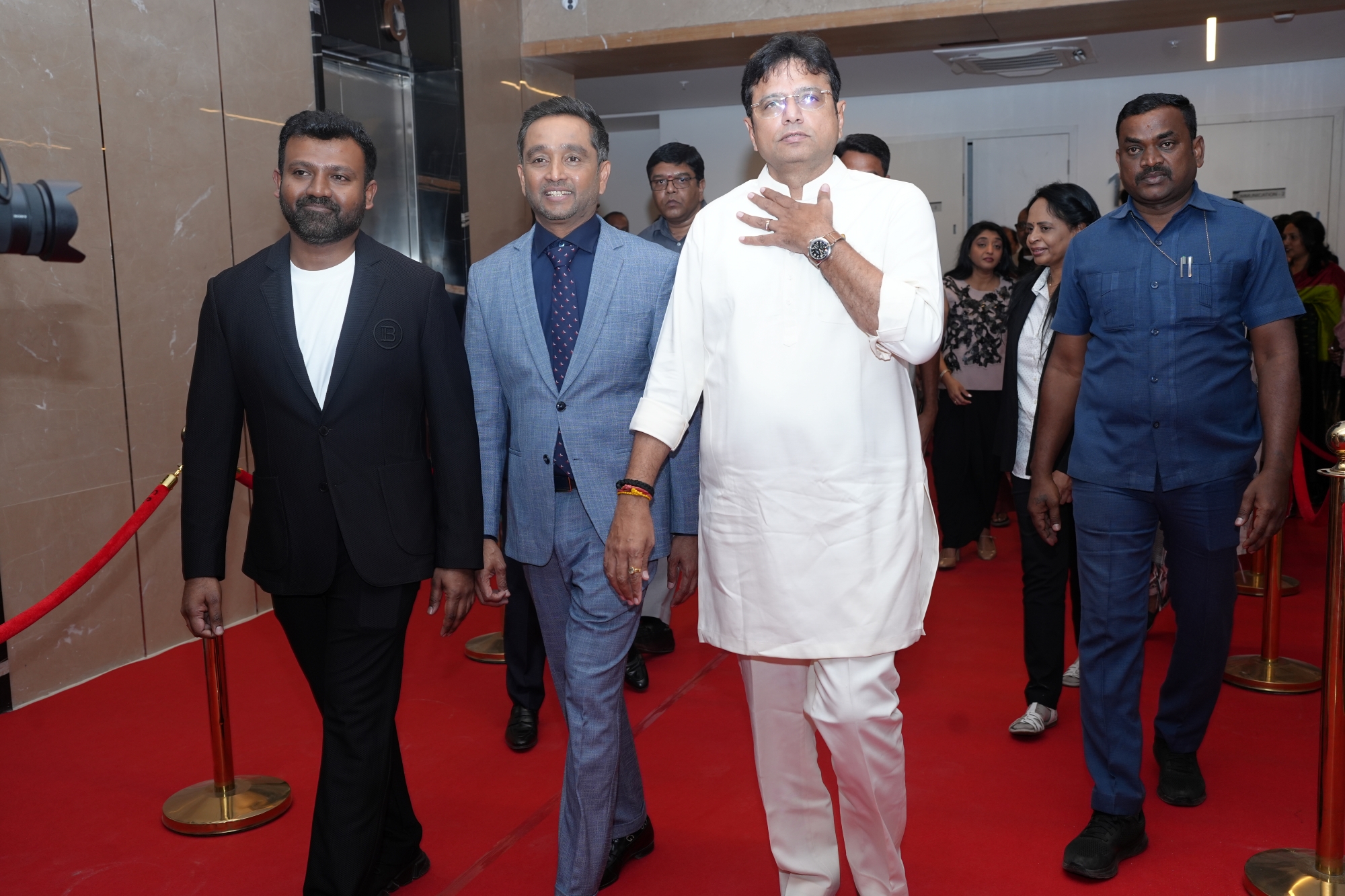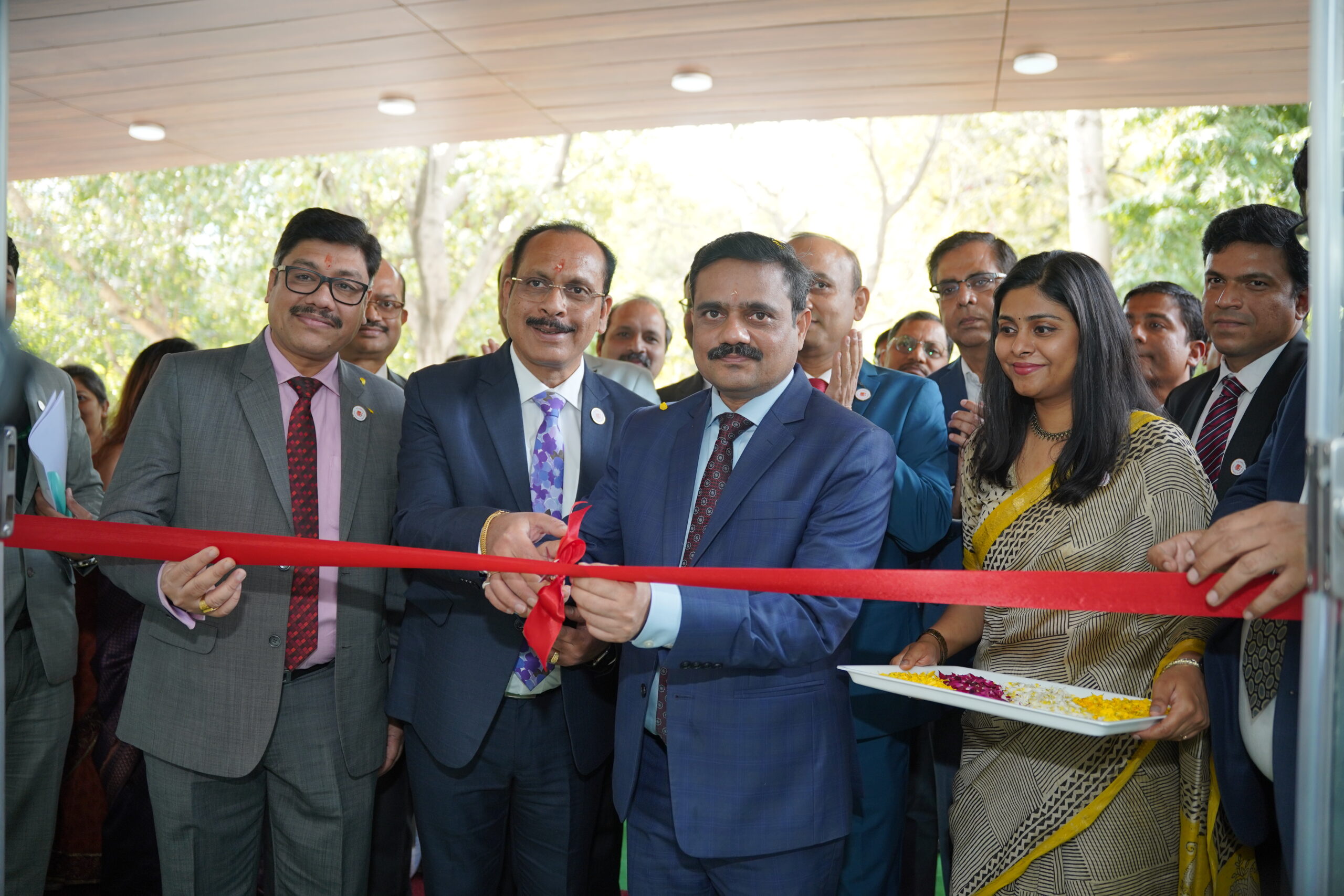Syneriq Global Opens AI-First GCC, Targets INR 150M Revenue
Hyderabad, India, March 14, 2025: Syneriq Global opened its new AI Products, Solutions and Consulting Services GCC in Hyderabad on Wednesday, enabled by Mergen Global. The new state-of-The-Art 40,000 square foot facility, established with an investment of ₹50 Crores will strengthen Syneriq Global’s position in the Global Digital Sector. Additionally, the group launched new AI platform, Zyrix, focused on driving Innovation and advancing product engineering.
For more than ten years, Syneriq Global has led Digital Transformation efforts, offering specialized services in Product Engineering, Quality Engineering, and expertise in Salesforce, ServiceNow, Databricks, and Snowflake,committed to helping businesses build solutions that are ready for the future. Kairos Technologies, a Syneriq group company, has received AI game changer award from NASSCOM in 2024.
Sri. D. Sridhar Babu, Minister for IT, E&C and I&C, and Legislative Affairs, Govt. of Telangana, formally inaugurated the facility on Wednesday along with Sri. K. Madan Mohan Rao, MLA from Yellareddy Assembly constituency in Nizamabad district, and Syneriq Global’s Leadership Team.
The company demonstrated its latest AI Powered Digital platform and solutions (Zyrix, KiTAP and DQ Gateway) developed by its innovation team in Hyderabad.
Furthermore, to expand its agility, and scalable approach to meet customer expectations worldwide, Syneriq Global will double its workforce to 1500 employees across its facilities globally

Syneriq Global is a global enterprise with a network of technology companies having operations in the United States of America, Mexico, Canada, South Africa, Hyderabad, and Visakhapatnam.
After taking a tour of the new facility, Minister Sri. D. Sridhar Babu, in his address highlighted “Sudhakar Pennam’s remarkable legacy in building globally scalable enterprises demonstrates his Vision and Innovation. This kind of success aligns perfectly with our state’s goal to make Hyderabad the AI City, and to foster a thriving Artificial Intelligence Ecosystem and attract visionary leaders who can drive both local and global growth.”
Expressing his gratitude to the IT Minister for gracing the occasion Sudhakar Pennam Founder, Syneriq Global said, Telangana’s progressive policies are driving AI sector growth at a rapid scale, and we are committed to contributing to itsvision to become a global AI city. Our new Global Capability Centre in Hyderabad is a key milestone for our goal to become a $150 Million Group. We will continue to invest in R&D, drive innovation in our full stack of next generation AI Technologies, helping enterprises to harness these emerging technologies, and build a strong talent base in Hyderabad.”
Mahanth Mallikarjuna, CEO of Mergen Global, saidSyneriq Global’s new GCC in Hyderabad represents a significant step forward in delivering cutting-edge digital innovation, meeting the evolving needs of the digital sector —today, tomorrow, and beyond. This expansion enables us to drive transformational change and empower businesses to thrive in an increasingly digital world.”
Syneriq Global, founded by Serial Entrepreneur Sudhakar Pennam, known for his entrepreneurial acumen and startup success stories, played a pivotal role during his tenure as a CEO of Cigniti, which was later acquired by Coforge.
Global Industry Growth Trends: The need for high-quality technological solutions has never been greater. According to Markets and Markets, the Global Software Testing Market is projected to grow at a 10% CAGR, reaching $65.7 billion by 2028. Similarly, the Salesforce Automation Market is expected to reach $40 billion by 2027, driven by the demand for streamlined sales processes and operational efficiency. Additionally, the ServiceNow Market is on track to grow at a remarkable 22.5% CAGR, reaching $23.76 billion by 2025. This increasing demand highlights the importance of Integrated, Automated Solutions for Businesses Globally.
Binance IWD Panel Highlights Mentorship for Women in Leadership
India, March 14, 2025 – In celebration of International Women’s Day, Binance hosted an insightful panel discussion featuring Rachel Conlan, Global Chief Marketing Officer at Binance, and Medha Srivastava, General Counsel at Hashed. The session was moderated by Jessica Walker, Global Media and Content Lead at Binance, another inspiring woman leader at the company. The discussion highlighted the importance of mentorship, work-life balance, and career growth for women in male-dominated industries
With a career spanning more than 15 years, Medha shared her journey as a qualified lawyer, emphasizing how mentorship has played a vital role in shaping her career from an early age. She credited her parents’ learnings and early exposure to strong mentors as key factors in her professional growth. Medha also spoke about the figures who have inspired her throughout her journey, highlighting renowned author Elif Shafak as a key influence. She admires Shafak’s ability to challenge societal norms, advocate for inclusivity, and use storytelling as a powerful tool for change.
Similarly, Rachel Conlan reflected on the impact of her aunts in Ireland, her first internship at 15, and the importance of networking and diverse perspectives in career development. She also drew inspiration from top women business leaders like Coco Chanel and Suzie Wealth.
During the Q&A session, where questions were exclusively submitted by Binance users in advance, Rachel and Medha addressed key topics around mentorship, career decisions, and work-life balance.
Rachel shared how she initially faced resistance when transitioning into the crypto industry, highlighting the need to make independent decisions and educate others about one’s career choices. Medha echoed similar sentiments, emphasizing that many people do not fully understand the nature of their work and the importance of personal well-being through activities like walking, working out, and taking personal time.
The leaders also discussed work-life balance, a pressing concern for women professionals in fast-paced industries. Rachel acknowledged the demanding nature of all-encompassing industries but stressed the need to understand one’s own capacity and find balance. Medha highlighted that the challenge is not exclusive to crypto but extends to other industries such as law. She spoke about sustainable success, the need for setting personal boundaries, prioritizing tasks, and maintaining well-being through fitness and meditation. She also pointed out that women tend to be too harsh on themselves, reinforcing the need for self-care.
On career mentorship, Rachel noted that early in her career, she was unsure of her direction but learned to recognize opportunities that aligned with her role. Medha emphasized the importance of managers who provide constructive feedback, teaching lessons from mistakes rather than simply reprimanding employees.
The panel served as an inspiring conversation on the challenges and triumphs women face in the workplace. Both Rachel and Medha reinforced the need for strong mentorship, resilience, and balance in building successful and sustainable careers. Their insights provided valuable guidance to aspiring professionals, making the discussion a significant step toward furthering workplace empowerment for women.
Speaking on the panel discussion, Rachel Conlan, Global CMO, Binance, said, “Building a successful career is not just about working hard, it is about being intentional with your choices, seeking out diverse perspectives, and having the confidence to step into new opportunities, even when the path isn’t fully defined. In fast-evolving industries like crypto, there will always be skepticism, but true growth comes from trusting your decisions, continuously educating yourself, and surrounding yourself with people who challenge and inspire you. Mentorship, resilience, and the ability to adapt are key drivers of long-term success.”
Medha Srivastava, General Counsel, Hashed, added, “Sustainable success at the workplace in any industry, whether legal, crypto, or beyond, is not about being available 24/7 but about setting clear boundaries, prioritizing tasks effectively, and maintaining personal well-being. Women often hold themselves to incredibly high standards, sometimes at the cost of their own balance. It’s crucial to recognize that success is not just about relentless work but also about mentorship, learning from challenges, and creating an environment where growth and self-care can coexist. A strong support system and the right leadership can make all the difference in shaping one’s professional journey.’’
Nephro Care India Secures Public Engagement with an Insightful Session on Kidney Health
Kolkata, March 14, 2025: With kidney disease turning into an epidemic in India where one in every eleven individuals is at risk of renal failure, prevention is set to play a crucial role in ensuring good kidney health. On the occasion of World Kidney Day 2025, Nephro Care India Limited (NCIL) organized an interactive session on the theme: “Are Your Kidneys OK? Detect Early, Protect Kidney Health” to generate awareness among masses regarding kidney health.
The interactive session, which was livestreamed on Youtube and Facebook, was moderated by Senior Nephrologists from across the country including Dr Pratim Sengupta, MD & CEO, NCIL; Dr Bharat Shah, MD, DNB (Nephrology); Dr Sourav Sadhukhan, MD Medicine, DM, Nephrology; Dr Prabhav Bhansaly, MD Medicine, DM, Nephrology and Dr Arindam Dutta, MS, MCh (Urology).
Over 500 registered participants attended the live session from India and Bangladesh and received a first-hand guidance from renowned health practitioners on the do’s and don’t’s for maintaining healthy lifestyle and good kidney health.
According to Dr Sengupta, diabetes and hypertension are the leading causes, contributing to over 30 per cent of chronic kidney cases. Painkiller abuse ranks third as a significant factor. The disease often progresses silently, with symptoms emerging only after significant kidney damage has occurred.
“India adds close to 2.5 lakh new patients every year to the pool of people requiring dialysis support due to advanced kidney failure. There are around seven crore patients suffering from various chronic kidney diseases. Treatment of CKD, particularly at its advanced stage – ESRD (end-stage renal disease), consumes a huge proportion of health resources, which could be beyond the reach of the average Indian. Hence focusing on prevention is important. Just by making some simple changes in our lifestyle and food habits we can keep kidney disease at bay,” Dr Sengupta said.
“Symptoms of chronic kidney disease often develop gradually and is often not noticed in the early stages. Hence regular check ups and kidney function tests are essential for early diagnosis,” he added.
Strong and Compassionate: 14 Years of Saving Rajasthan’s Gentle Giants
New Delhi, March 14, 2025: In the arid landscapes of Rajasthan, camels have long been a symbol of resilience, carrying loads, transporting families, and serving as lifelines for many communities. Yet, thousands suffer from injuries, malnutrition, and neglect. Providing a haven for these gentle giants, the Camel Rescue Centre (CRC) in Bassi has been working tirelessly for the past 14 years to rescue, treat, and rehabilitate camels in need.

Ranu was abandoned, blind, and helpless. Blackie was rescued from smugglers. Rani spent years performing in a circus, while Martin, left lame from an injury, was no longer wanted. Each of them found safety and dignity at the CRC, where hundreds of camels have received life-saving care.
Established in 2011 by Help In Suffering (HIS) with support from the ELSU Foundation, CRC provides critical medical care for working camels—those used in transport, brick kilns, and tourism. Located 30 km from Jaipur, the centre treats 250-350 camels every month, offering emergency care and long-term rehabilitation.
“The centre is part of HIS’s camel welfare programme, running since 2001. Each year, 5,000-7,000 camels receive free veterinary care through mobile clinics, reaching remote areas where medical services are scarce. HIS also conducts annual treatment camps at major camel hubs like Pushkar, Jaisalmer, and Nagaur, treating thousands of camels during these events,” said Timmie Kumar, Managing Trustee, HIS.
Beyond medical care, HIS has introduced humane welfare measures, such as replacing wooden nose pegs with gentler alternatives, fitting over 1,000 camel carts with reflectors to prevent accidents, and conducting regular deworming programmes for 2,000 camels annually.
For many families, camels are their livelihood, yet without proper veterinary care, these animals suffer from preventable illnesses and injuries. The Bassi Centre bridges this gap, ensuring camels receive treatment while also training owners in better welfare practices.
“The Bassi centre was set up because there was nowhere else for these camels to go,” added Kumar. “We have treated, rescued, and rehabilitated thousands, but beyond the numbers, it’s about relieving suffering and supporting the people who depend on them.”
CRC veterinarians routinely treat camels for lameness, infections, digestive disorders, and respiratory diseases. Its mobile team reaches remote areas where veterinary care is often unavailable.
“Every camel has a story,” said Dr Abhinav Swani, Veterinary Doctor at CRC, Bassi. “Many have worked in extreme conditions for years. Others are abandoned once they are no longer useful. Our work gives them a second chance at life.”
The Camel Rescue Centre is one of several animal welfare initiatives by Help In Suffering (HIS), Jaipur, which continues to be a beacon of compassion for Rajasthan’s camels and the people who rely on them.
Sleepwell Commends Quality Rest with a Nationwide Sleep Revolution on World Sleep Day
Noida, March 14, 2025: This World Sleep Day, Sleepwell, India’s foremost sleep solutions brand is further reinforcing the brand’s bold step in addressing the nation’s sleep crisis through Did you Sleepwell? initiative. With a pioneering approach that blends science with awareness in a thought-provoking and inspiring manner, Sleepwell continues to lead the conversation on sleep health, reinforcing the brand’s commitment to go beyond selling products — a lasting impact on public well-being for their comfort and well-being.

With India’s growing sleep health concerns; Sleepwell has consistently spread sleep awareness through multiple initiatives that educate and encourage people to prioritize sleep. At the heart of this movement is the iconic ‘Did You Sleepwell?’ campaign, which is evolving into a daily ritual – a question that encourages self-reflection on sleep health for ourselves and our loved ones. From collaborations with the Indian Society for Sleep Research (ISSR) featuring expert-led insights, to various other integrated awareness campaigns, the brand has been at the forefront of spreading awareness on the importance of sleep.
Industry experts and influencers join the movement
Beyond advertising, Sleepwell is fostering meaningful conversations through expert-led articles, influencers and collaborations with experts like the Indian Society for Sleep Research. In addition, interactions with industry leaders, sleep researchers, and wellness influencers will drive home the message of sleep as a fundamental pillar of health and productivity.
Dr HN Mallick, President Indian Society for Sleep Research says “On this world sleep day, we have a message that is prioritising sleep health. People are aware about nutrition, exercise or side effects of addictions like alcohol and tobacco, however they are not aware about side effects of a compromised sleep health, especially when it is ignored and compromised for various reasons including modern lifestyle. So it’s the right time to give importance to sleep health. Sleep is important for longevity and prevention of various diseases. Sleep on time, sleep regularly and sleep adequately.”
At Sleepwell, the belief in better sleep isn’t just about products—it’s about creating real change. This World Sleep Day, the brand is turning its philosophy inward through small yet meaningful gestures—such as allowing employees to start work two hours later and offering special incentives to housekeeping and early shift workers—reflect the company’s core philosophy: Comfort begins with comforting others.
Taking the conversation nationwide
To make a real impact, Sleepwell is ensuring its message reaches people across the country through its media strategy with top-tier publications like XX and XX, along with leading digital platforms, driving the conversation.
As lifestyles grow sedentary and Sleep is often neglected, health issues are on the rise. A conversation by Sleepwell in promoting the role of sleep and sleep awareness is a step towards redefining India’s relationship with sleep.
Mr. Nilesh Mazumdar, CEO Sheela Foam says “ “At Sleepwell, we believe that quality sleep time of 7-9 hours for recharging our mind and body from daily stress is non-negotiable. Our collaboration with Indian Society for Sleep Research has strengthened our movement to spread sleep awareness that is backed by science. Through our initiative of Did you Sleepwell?, we aim to encourage individuals to prioritize sleep as an essential pillar for a healthier life.”
Samsung Secures the Lead with Galaxy F16 5G Launch in India
Bengaluru, India – March 14, 2025: Samsung, India’s largest consumer electronics brand, today announced the launch of the Galaxy F16 5G, expanding its popular Galaxy F series portfolio. The Galaxy F16 5G continues the legacy of the Galaxy F series, offering fun and segment-leading features such as a stunning sAMOLED display, 50 MP triple camera, and a promise of six generations of Android upgrades and six years of security updates.
“The launch of the Galaxy F16 5G reaffirms our commitment to meaningful innovation, empowering users to reach their full potential. Galaxy F16 5G is tailored for Gen Z’s fast-paced lifestyle and seamlessly blends performance, longevity, and fun for an exceptional user experience,” said Akshay S Rao, Director , MX Business, Samsung India.
All New Design and Segment Leading Display
Boasting a refreshing new design with a Ripple Glow Finish and measuring just 7.9mm slim, Galaxy F16 5G is crafted for both style and comfort. Galaxy F16 5G will feature segment-leading 6.7″ FHD+ sAMOLED display, delivering stunning visuals with vibrant colours and deep contrasts.
Segment Leading Camera
Featuring a stylish, linear-grouped camera design, Galaxy F16 5G’s segment-leading 50MP triple-camera setup helps users capture stunning photos and videos. Galaxy F16 5G also features a 13MP front camera for stunning selfies.
Powerful Performance
Powered by MediaTek Dimensity 6300 processor, Galaxy F16 5G ensures smooth multitasking and lag-free gaming. Galaxy F16 5G comes with a 5000mAh battery with 25W fast charging to keep users powered throughout the day.
Galaxy Foundations
Setting new industry benchmarks, Galaxy F16 5G will offer segment’s best 6 generations of Android upgrades and 6 years of security updates, ensuring a future-ready experience.
Samsung is also introducing its innovative Tap & Pay feature with Samsung Wallet for the first time in this segment with the Galaxy F16 5G, allowing consumers to make secure payments effortlessly.
Galaxy F16 5G will come in three stunning colours- Vibing Blue, Glam Green and Bling Black and will be available on Flipkart, Samsung.com and across select retail stores.
Desperation Meets Deception in ‘Loot Kaand’ Trailer for Amazon MX Player
Mumbai, 14 March 2025: The countdown to an adrenaline-fueled heist has begun! Amazon MX Player, Amazon’s free video streaming service, has dropped the high-octane trailer for its highly-anticipated heist drama Loot Kaand. Directed by Ruchir Arun and created by Saurav Dey, the series is produced by Drishyam Films and N2O Films, and boasts a stellar cast, featuring Tanya Maniktala, Sahil Mehta, Gyanendra Tripathi, and Saad Bilgrami in pivotal roles. Packed with a gripping narrative, unpredictable twists, and intense tension, Loot Kaand is all set to stream from 20th March exclusively on Amazon MX Player, for free.
The trailer offers a thrilling first look at the chaos that unfolds when money, power, and survival collide. Set in a quiet and mysterious town of West Bengal, the series follows siblings Latika and Palash, who are on the edge of financial ruin. Desperate to escape their circumstances, they orchestrate a daring bank heist— with an unlikely accomplice, that gives them more than what they had signed up for. The ticket to freedom that they set out on, soon spirals into a deadly game, full of gangsters, law enforcement officers, and unseen enemies lurking in the shadows. As the noose tightens around Latika and Palash, one thing that becomes clear from the drama is that there’s never an easy way out to succeed.

Amogh Dusad, Head of Content, Amazon MX Player, said, “We constantly strive to push the envelope with our storytelling, and Loot Kaand is a testament to that ambition. This series is a high-stakes thriller packed with gripping tension, emotions, and moral dilemmas that are bound to leave audiences on the edge of their seats, as every decision carries weight, and every twist leads to unforeseen consequences. The trailer offers just a glimpse, but the real thrill begins when the story unfolds.”
Talking about the show, Raghav Gupta, Producer, said, “It was magical to see Ruchir bring Saurav da’s vision to life. It was a wonderful journey with Amazon MX Player and we are excited to share Loot Kaand with the audience.”
Talking about her character Latika in the series, Tanya Maniktala shared, “Latika is fearless, yet flawed– a woman fighting to break free, but at what cost? Every choice she makes carries consequences, making her journey both engrossing and intense. Loot Kaand isn’t just a heist story—it’s a tale of survival, desperation, and the burden of decisions. The trailer teases a taste of the chaos, but the real experience lies ahead. I can’t wait for audiences to immerse themselves in this riveting world.”
Reflecting on the show’s absorbing intensity, Gyanendra Tripathi added, “The beauty of Loot Kaand lies in its unpredictability. Every character is layered with battles of their own, and no one is entirely good or bad. The stakes are sky-high, the risks are real, and the choices they make will alter their fates forever. I can’t wait for the audience to dive into this world and experience it for themselves.”
Team of Renowned Experts Joins the Medical Team at Manipal Hospital, Baner
Pune, March 14, 2025: Manipal Hospital, a leading healthcare institution in Pune, welcomes 4 new doctors to their team of experts. These new doctors will further strengthen the medical expertise of healthcare delivery to patients suffering from different heart, neurological and orthopedic conditions.
Dr. Suhas Hardas, a consultant cardiologist with 39 years of experience and a pioneer in ASD closure, CRT implantation, and radial rotablation; Dr. Rakesh Ranjan, a consultant neurosurgeon with 25 years of experience specializing in micro neurosurgery, minimally invasive procedures, and pediatric neurosurgery; and Dr. Abhijit Agashe, a consultant orthopedic surgeon with over 21 years of experience specializing in joint replacement, sports injuries, robotic knee replacements, hip replacements, and joint surgeries, have joined the esteemed medical team at Manipal Hospital, Baner.
Mr. Anand Mote, Cluster Director, Manipal Hospital Baner, Pune, said, “We are delighted to welcome our esteemed new doctors to our medical team. Their expertise perfectly aligns with our commitment to delivering exceptional healthcare services to the people of Pune. With the addition of Dr. Hardas, Dr. Ranjan, and Dr. Agashe, we are confident in further enhancing the quality of care and making a meaningful impact in the lives of patients facing neurological, orthopedic, and cardiac conditions.”
TVS Motor & Petronas Strengthen Partnership for Indian Motorsport
Bengaluru, March 13, 2025: TVS Motor Company (TVSM) – a leading global automaker in the two and three-wheeler segment – has further strengthened its partnership with PETRONAS Lubricants International (PLI) to elevate the Indian motorsport landscape. Under this expanded alliance, PLI will continue to be the title sponsor of TVS Racing – the country’s first factory racing team – for the next three years, supporting the team’s participation in the Indian National Supercross Championship (INSC), Indian National Rally Championship (INRC), and Indian National Motorcycle Racing Championship (INMRC). This partnership reaffirms the shared commitment of two companies towards promoting motorsports in India while reinforcing PLI’s position in the country’s high-performance lubricants market.
PETRONAS has been the title sponsor of TVS Racing across the 2022-2023 season, complementing the team’s four-decade legacy in Indian motorsports. As part of this partnership, PLI will continue as the official supplier of after-market oils to TVSM’s extensive dealership network. The PETRONAS TVS TRU4 product range will offer premium semi and full synthetic lubricants designed for high-performance TVS motorcycles, further enhancing engine efficiency and longevity. This collaboration not only reinforces PLI’s footprint in India’s two-wheeler market but also aligns with TVS Racing’s commitment to innovation and excellence in motorsports.

Speaking on the partnership, Vimal Sumbly, Head Business – Premium, TVS Motor Company, said, “TVS Racing is a pioneer of motorsports in India and has consistently secured more than 80% win rate across multiple formats of racing. This racing pedigree directly influences our Apache series, bringing race-derived performance and technology to our customers. With over four decades, TVS Racing has played a pivotal role in democratizing motorsports in India and nurturing world-class talent with its programs like the TVS One Make Championship. Strengthening our partnership with PLI underscores our shared commitment to pushing the boundaries of performance and innovation. Their cutting-edge technology and experience in premier racing events perfectly compliments our vision for the sport. PLI’s expertise in fluid technology, combined with our racing heritage, will continue to shape the future of two-wheeler racing in India.”
Binu Chandy, Chief Executive Officer of PETRONAS Lubricants India (Pvt) Ltd said, “Our collaboration with TVS Racing has been instrumental in demonstrating the synergy between high-performance lubricants and motorsport excellence. This partnership not only strengthens our presence in India’s dynamic two-wheeler market but also aligns with our broader energy ambitions in the country. Our motorsports legacy, combined with TVS Racing’s dominance in Indian motorsports for over 40 years, positions us to drive the sport forward. We are excited to support TVS Racing as we continue this journey together.”
TVS Racing continues to dominate national and international motorsports, with Aishwarya Pissay extending her winning streak at the Bajas Championship and the TVS Asia One Make Championship (OMC) concluding a successful third season with 15 racers from nine countries. On the national stage, the team secured Teams & Manufacturer titles in INMRC Pro Stock (165cc & 301-400cc), championships across all INRC categories, and strong podium finishes at the INSC. The 14th season of TVS Indian OMC also wrapped up successfully, featuring 50 of India’s top racing talents.
With its ‘Track to Road’ philosophy, TVS Racing continues to shape the TVS Apache series, integrating race-derived technology into high-performance motorcycles. The PETRONAS TVS Racing Team remains committed to pushing the boundaries of motorsports excellence, setting new benchmarks across key racing formats.
As TVS Racing and PLI strengthen their partnership, their shared expertise and vision will continue to inspire riders and motorsports enthusiasts, driving new milestones in two-wheeler racing.


